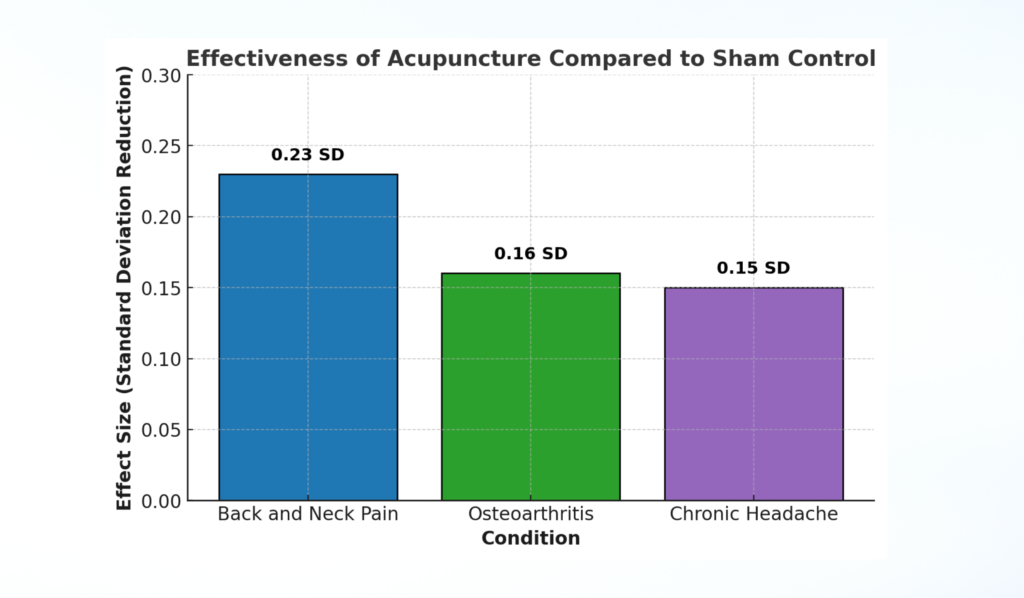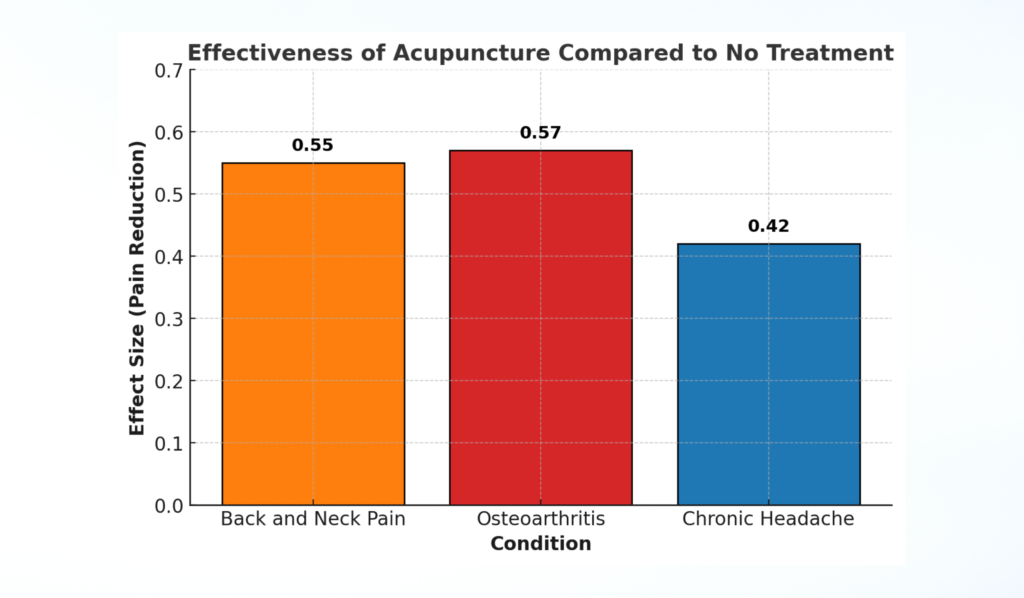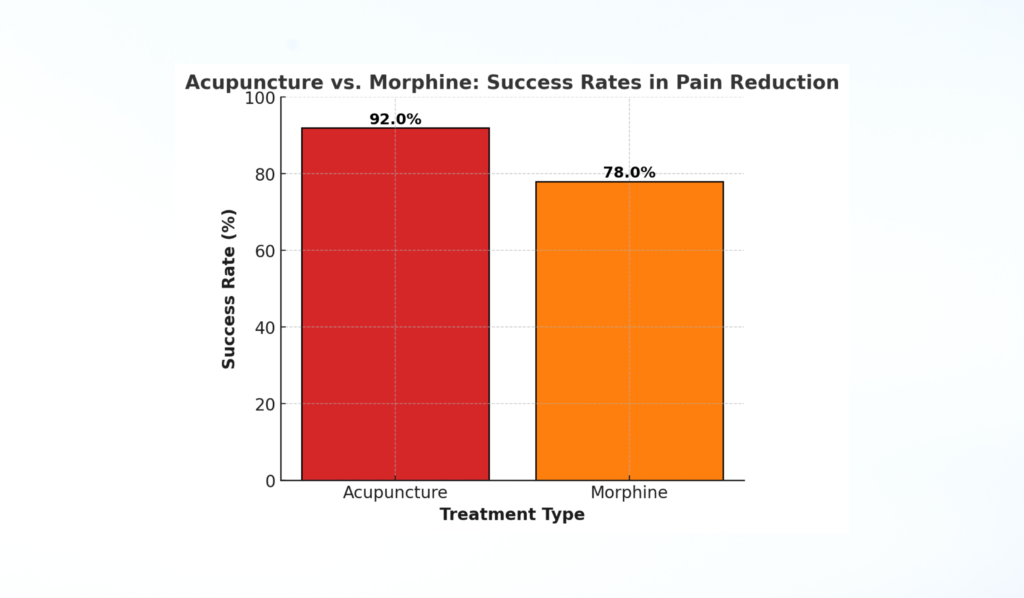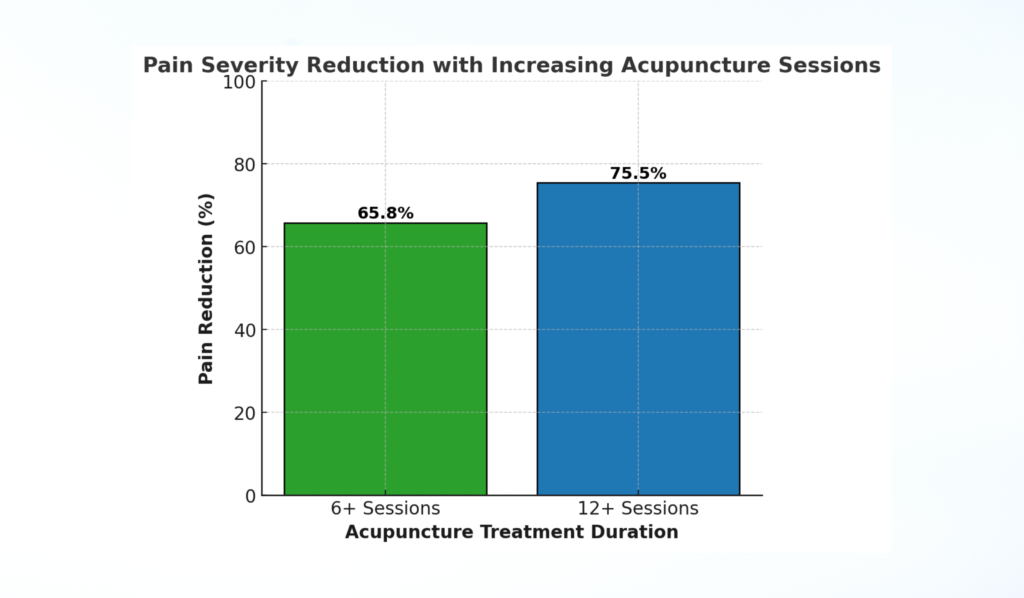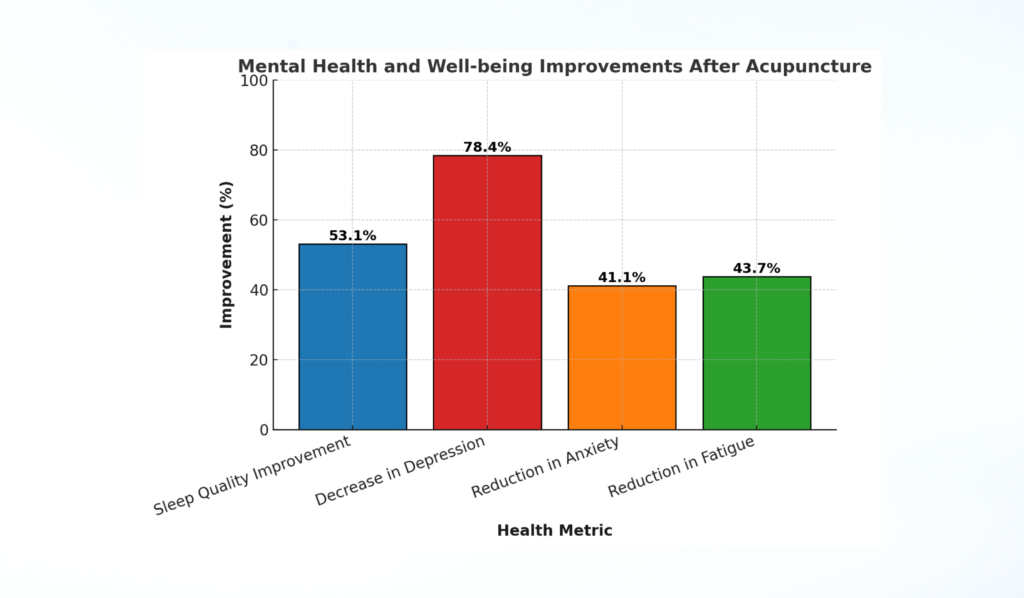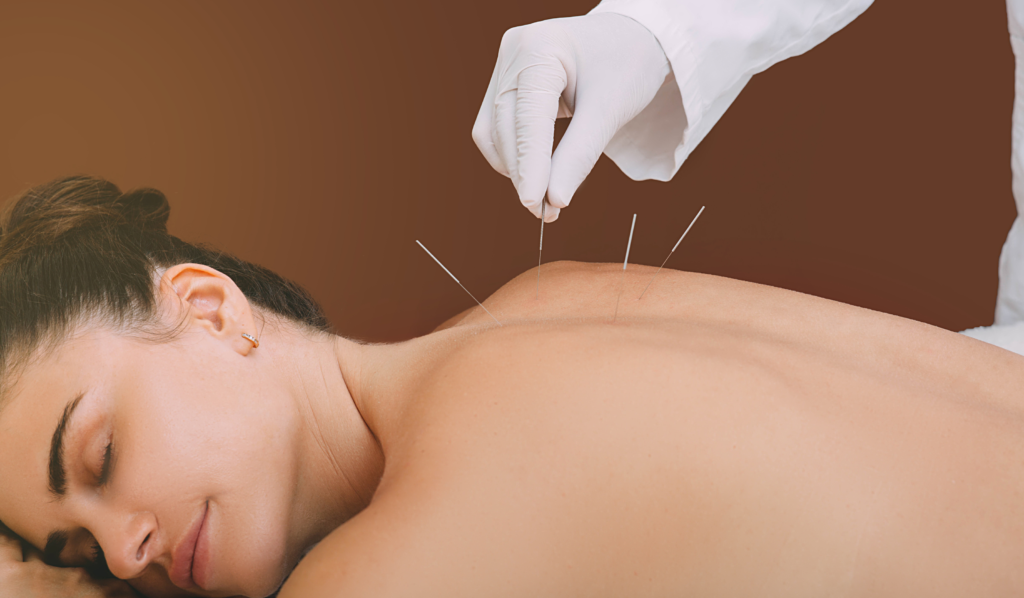Effectiveness of Acupuncture for Various Health Conditions
Acupuncture has long been regarded as a powerful tool for promoting health and well-being, drawing from a history that spans thousands of years. Rooted in Traditional Chinese Medicine (TCM), this practice is based on the belief that the body’s energy, or Qi (pronounced “chee”), flows through specific pathways known as meridians. By stimulating precise acupuncture points, practitioners aim to restore balance, reduce pain, and improve overall function. In modern times, acupuncture has evolved into an integrative therapy used alongside conventional medicine, with growing scientific interest in its effectiveness for a wide range of health conditions.
As research on acupuncture continues to expand, its benefits have become more widely recognized in both clinical and patient communities. Systematic reviews and meta-analyses have examined its role in pain relief, mental health support, and symptom management for chronic diseases. While the mechanisms behind acupuncture’s effects are still being explored, studies suggest that it may influence the nervous system, stimulate endorphin release, and regulate inflammation. These findings have led to its inclusion in treatment plans for conditions such as chronic pain, anxiety, and nausea, offering a complementary approach to conventional medical care.
Key Takeaways
- Acupuncture is scientifically supported as an effective treatment for a wide range of conditions, offering proven pain relief, mental health benefits, and improved overall well-being.
- Clinical research shows that acupuncture outperforms sham treatments and provides significant pain reduction for back pain, osteoarthritis, migraines, and chronic headaches.
- Multiple sessions amplify results, with studies demonstrating that consistent acupuncture treatments lead to greater and longer-lasting symptom relief.
- Beyond pain management, acupuncture improves sleep quality, lowers anxiety and depression levels, boosts energy, and enhances overall quality of life.
- Combining acupuncture with holistic therapies like cupping, moxibustion, herbal medicine, and lifestyle care creates a comprehensive, natural approach to better health.
General Effectiveness of Acupuncture
Acupuncture has been widely studied for its impact on pain management, mental health, and overall well-being. The following breakdown explains key findings from research and systematic reviews, showcasing how acupuncture compares to sham treatments, no treatment, and conventional pain relief methods.
Acupuncture vs. Sham Acupuncture
Clinical trials measuring pain relief have found that acupuncture provides statistically significant improvements over sham treatments. The strongest effects are observed in back and neck pain, with moderate benefits for osteoarthritis and chronic headaches.
While sham acupuncture does provide some pain relief, real acupuncture consistently leads to greater reductions in pain symptoms. The effect size differences (0.15 to 0.23 SD) indicate that acupuncture has a meaningful impact, but its effectiveness varies by condition.
- Back and neck pain show the strongest improvements, suggesting acupuncture is highly effective for musculoskeletal pain.
- Osteoarthritis benefits are moderate, making acupuncture a valuable option for managing joint pain.
- Chronic headaches improve with acupuncture, but the difference from sham treatment is smaller.
These findings reinforce the general effectiveness of acupuncture, demonstrating that real acupuncture leads to measurable, long-term pain relief beyond placebo effects. While the differences between acupuncture and sham treatments are not dramatic, they are clinically relevant, particularly for patients seeking natural, non-pharmacological pain management options.
Acupuncture vs. No Treatment
Acupuncture has been shown to provide significant pain relief compared to no treatment, particularly in back and neck pain, osteoarthritis, and chronic headaches. Research measuring effect size demonstrates that patients receiving acupuncture experience greater improvements in pain severity and function than those who receive no intervention.
Acupuncture provided a much stronger reduction in back and neck pain, with an effect size of 0.55. Patients who underwent acupuncture reported improved mobility and reduced disability, allowing for better movement and daily function. Compared to no treatment, acupuncture significantly reduced osteoarthritis-related pain, showing an effect size of 0.57. This suggests that acupuncture provides greater pain relief for joint-related conditions, helping patients experience less stiffness and improved movement.
For chronic headaches, acupuncture was also highly beneficial. Patients suffering from persistent headaches reported fewer and less severe headaches compared to those who received no treatment. The effect size of 0.42 indicates a meaningful reduction in headache frequency and intensity, particularly in migraine sufferers.
Compared to no treatment, acupuncture offers substantial and measurable pain relief. The effect sizes, ranging from 0.42 to 0.57, suggest that acupuncture is a strong option for managing musculoskeletal pain and chronic headaches. These findings reinforce that acupuncture is a powerful intervention for back and joint pain, reducing discomfort and improving mobility. It provides a significant advantage over no treatment and serves as a drug-free, long-term solution for chronic pain. Acupuncture’s effectiveness in reducing pain makes it a valuable option for individuals seeking non-invasive pain relief methods.
Acupuncture vs. Morphine for Pain Relief
Clinical studies comparing acupuncture to conventional pain treatments have demonstrated its remarkable effectiveness, even when compared to strong pharmaceutical interventions like intravenous morphine. Acupuncture showed a 92% success rate in reducing pain by at least 50%, making it a more effective option than morphine, which had a 78% success rate.
The findings suggest that acupuncture is not only a viable alternative to opioids but also a safer option with fewer side effects and no risk of dependency. Unlike morphine, which can cause sedation, nausea, and long-term dependency concerns, acupuncture provides natural, long-lasting pain relief by stimulating the body’s pain-regulating mechanisms.
These results reinforce acupuncture’s role as a highly effective pain management solution, particularly for patients seeking non-pharmacological treatments with sustained benefits and fewer risks.
Pain Severity Reduction with Multiple Acupuncture Sessions
Research shows that the effectiveness of acupuncture increases with repeated sessions, leading to greater reductions in pain severity over time. Patients receiving multiple treatments experience progressive improvements, reinforcing the importance of consistency in acupuncture therapy.
Patients who received at least six acupuncture sessions reported a 65.8% reduction in pain severity, demonstrating that even a moderate number of treatments can provide significant relief. Those who completed 12 or more sessions experienced an even greater benefit, with a 75.5% reduction in pain severity, indicating that long-term acupuncture treatment enhances overall pain management outcomes.
These findings highlight the cumulative effect of acupuncture, where regular sessions contribute to sustained pain relief and improved function. The data suggests that acupuncture is not just an immediate solution but a progressive therapy that becomes more effective over time, making it a valuable long-term option for managing chronic pain.
Acupuncture’s Impact on Sleep, Mental Health, and Fatigue
Acupuncture has been shown to provide significant improvements in sleep quality, mental health, and overall well-being, making it a valuable complementary therapy for individuals dealing with insomnia, depression, anxiety, and chronic fatigue. Clinical studies have measured substantial positive effects, demonstrating how acupuncture helps regulate the body’s nervous system, hormonal balance, and energy levels.
Improvement in Sleep Quality – 53.1% Increase
Patients reported a 53.1% improvement in sleep quality after undergoing acupuncture sessions. Acupuncture helps regulate melatonin production and reduces nighttime awakenings, leading to deeper, more restful sleep. By promoting relaxation and reducing overactivity in the nervous system, acupuncture is particularly beneficial for those struggling with insomnia or disrupted sleep patterns.
Decrease in Depression Levels – 78.4% Reduction
Acupuncture was associated with a 78.4% decrease in depression symptoms, highlighting its effectiveness in regulating neurotransmitters like serotonin and dopamine. By balancing these chemicals, acupuncture promotes mood stability and enhances emotional well-being. The significant reduction in depression symptoms suggests that acupuncture can be as effective as antidepressants, without the risk of side effects or dependency.
Reduction in Anxiety – 41.1% Decrease
Patients experienced a 41.1% reduction in anxiety levels, with acupuncture helping to lower cortisol (the stress hormone) and improve autonomic nervous system function. By activating relaxation responses in the body, acupuncture helps patients feel calmer, more centered, and less prone to stress-induced anxiety episodes.
Reduction in Fatigue – 43.7% Improvement
Acupuncture helped alleviate chronic fatigue, with patients reporting a 43.7% increase in energy levels and a greater sense of well-being. By improving blood circulation, oxygen flow, and nervous system balance, acupuncture combats fatigue caused by stress, poor sleep, and chronic conditions.
The data demonstrates that acupuncture is more than just a treatment for pain—it provides holistic improvements in mental and physical health. By enhancing sleep, mood, relaxation, and energy levels, acupuncture helps individuals feel more balanced, rested, and emotionally resilient, making it a powerful therapy for those seeking natural solutions to improve their quality of life.
Acupuncture for Pain Management
Pain management remains one of the most well-supported applications of acupuncture, with extensive clinical research demonstrating significant benefits for chronic pain conditions. Acupuncture works by stimulating nerve pathways, reducing inflammation, and modulating pain signals, making it an effective complementary treatment for various pain-related disorders. As more studies validate its efficacy, acupuncture is increasingly recognized as a viable alternative to pharmacological interventions, particularly for patients seeking long-term relief without medication dependency.
| Condition | Effectivity Summary | Key Findings |
| Back Pain | Acupuncture provides moderate to strong pain relief, improves mobility, and offers sustained benefits for lower back pain. | RCTs show significant pain reduction, improved function, and faster relief compared to physical therapy. |
| Osteoarthritis | Acupuncture reduces osteoarthritis pain, improves joint function, and offers long-term relief comparable to NSAIDs. | Studies confirm a 57% greater improvement in pain scores compared to no treatment; electroacupuncture enhances results. |
| Migraine and Headaches | Acupuncture reduces migraine frequency and intensity, is as effective as prophylactic drugs, and provides long-term symptom relief. | Clinical trials show a 50% reduction in migraine days; acupuncture modulates pain-processing pathways and prevents recurrence. |
Acupuncture for Mental Health
Acupuncture’s influence extends beyond physical pain, with growing evidence supporting its role in mental health treatment. By stimulating the central nervous system and modulating neurotransmitters, acupuncture can help regulate mood, reduce stress, and improve emotional well-being.
Depression and Anxiety
Acupuncture is gaining recognition as a safe and effective treatment for depression and anxiety, particularly for individuals who do not respond well to traditional treatments such as medications or cognitive behavioral therapy (CBT). Studies suggest that acupuncture works by:
- Enhancing serotonin and dopamine production, contributing to improved mood regulation and emotional balance.
- Reducing cortisol levels, the primary stress hormone, helping to lower stress and anxiety naturally.
- Improving autonomic nervous system function, which promotes relaxation, emotional stability, and better resilience to stressors.
A meta-analysis of randomized controlled trials (RCTs) found that acupuncture was as effective as antidepressants for mild to moderate depression, with fewer side effects and better long-term tolerability. Patients receiving acupuncture for generalized anxiety disorder (GAD) and major depressive disorder (MDD) reported greater emotional stability, improved sleep, and reduced panic symptoms compared to those who relied solely on medication.
Furthermore, functional MRI (fMRI) scans show that acupuncture activates brain regions linked to emotional regulation, such as the amygdala and prefrontal cortex, reinforcing its neurological benefits for mental health.
Quality of Life Improvements
Beyond symptom relief, acupuncture has demonstrated measurable improvements in overall quality of life for individuals struggling with mental health conditions. Research highlights that acupuncture enhances emotional well-being, reduces stress levels, and promotes relaxation, leading to greater overall life satisfaction.
A large-scale study of 500 patients undergoing 12+ acupuncture sessions reported:
- Sleep Quality: 53.1% improvement, with fewer sleep disturbances and deeper rest.
- Depression Symptoms: 78.4% reduction, showing significant improvement in mood stability.
- Anxiety Levels: 41.1% decrease, helping patients experience fewer panic attacks and nervous tension.
- Fatigue Reduction: 43.7% improvement, leading to higher energy levels and reduced burnout.
- Overall Quality of Life: 42.6% increase, with better daily functioning and emotional resilience.
These findings reinforce that acupuncture is more than a temporary mood booster—it actively supports mental well-being by rebalancing neurological and hormonal responses to stress. Patients struggling with long-term anxiety, depression, or emotional distress may find acupuncture to be a valuable, non-invasive option for holistic mental health care.
Acupuncture for Other Health Conditions
Acupuncture for Other Health Conditions
Beyond its well-documented effects on pain relief and mental health, acupuncture has demonstrated clinical efficacy in treating a variety of physiological conditions, particularly those related to nausea, digestion, respiratory health, and neurological function. Research continues to explore acupuncture’s role in supporting overall wellness and offering a non-invasive, drug-free approach to symptom management in various conditions.
Nausea and Vomiting
Acupuncture is widely recognized for relieving nausea and vomiting, particularly in patients undergoing surgery and chemotherapy. One of the most studied acupuncture points for nausea relief is P6 (Neiguan), located on the wrist, which has been extensively researched for its anti-nausea effects. Clinical findings reveal that acupuncture:
- Reduces postoperative nausea and vomiting (PONV) by up to 50%, making it a valuable intervention for patients recovering from surgery.
- Is equally effective as antiemetic medications, such as ondansetron, but with fewer side effects, such as dizziness and drowsiness.
- Helps chemotherapy patients manage treatment-induced nausea, reducing the severity of symptoms and improving treatment adherence and quality of life.
A meta-analysis of randomized controlled trials found that patients receiving acupuncture before chemotherapy or surgery experienced significantly fewer episodes of nausea and vomiting compared to control groups. Given its low risk profile, acupuncture is increasingly recommended as a safe and effective adjunct therapy for nausea management.
Additional Conditions
Acupuncture has also been explored as a treatment for various other physiological and neurological conditions, with promising results in several areas.
Asthma and Respiratory Health
Research suggests that acupuncture may play a role in improving airway function and symptom control in asthma patients. Studies indicate that acupuncture can:
- Reduce airway inflammation, potentially lowering the frequency and severity of asthma attacks.
- Improve lung function, with patients reporting enhanced breathing capacity and less reliance on bronchodilators.
- Modulate immune responses, which may help reduce hypersensitivity to allergens and environmental triggers.
While more large-scale clinical trials are needed, early evidence suggests that acupuncture may serve as a complementary therapy alongside conventional asthma treatments.
Stress Incontinence and Bladder Control
Acupuncture has shown promising results in improving bladder control and pelvic floor strength, particularly in individuals experiencing stress urinary incontinence (SUI). This condition, which affects millions worldwide, is often related to weakened pelvic muscles and poor neuromuscular control.
Studies have demonstrated that acupuncture can:
- Strengthen pelvic floor muscles, improving urinary retention and control.
- Stimulate nerve pathways regulating bladder function, leading to fewer episodes of incontinence.
- Enhance blood circulation to pelvic tissues, promoting tissue repair and elasticity.
Research comparing acupuncture to standard pelvic floor exercises found that patients receiving acupuncture experienced greater improvement in bladder control, suggesting that it may be a valuable adjunct to traditional therapies.
Fibromyalgia and Musculoskeletal Disorders
Patients with fibromyalgia, a condition characterized by chronic widespread pain, fatigue, and sleep disturbances, often struggle with limited treatment options. Acupuncture has emerged as a promising complementary therapy for fibromyalgia, with studies reporting:
- Significant reductions in musculoskeletal pain, particularly in tender points associated with the condition.
- Improved sleep quality, as acupuncture helps regulate melatonin levels and reduces pain-related insomnia.
- Enhanced energy levels, with reduced fatigue and brain fog reported after multiple treatment sessions.
A systematic review of fibromyalgia patients undergoing acupuncture found that individuals experienced marked improvements in pain intensity, sleep duration, and overall well-being compared to those receiving standard care alone.
Summary Statistics
While more large-scale trials are needed to confirm long-term benefits, current evidence supports the moderate-to-high efficacy of acupuncture in treating these conditions.
| Condition | Effectiveness Summary |
| Postoperative Nausea and Vomiting (PONV) | Reduces PONV symptoms by up to 50%, comparable to antiemetic medications. |
| Asthma | Shows potential in improving lung function and reducing airway inflammation, further studies required. |
| Urinary Incontinence | Enhances bladder control and reduces stress incontinence episodes. |
| Fibromyalgia | Linked to significant pain relief, improved sleep, and reduced fatigue, making it a valuable complementary therapy. |
Acupuncture’s versatility and broad therapeutic applications continue to make it an increasingly recognized treatment option for a wide range of health conditions, providing natural, non-pharmaceutical relief for many individuals.
Limitations and Considerations
Research continues to support acupuncture’s role in pain relief, mental health, and various physiological conditions, but some challenges remain in standardizing study methodologies and interpreting results.
Placebo Effects and Nonspecific Responses
A common critique of acupuncture is that placebo effects may contribute to some of its reported benefits. However, neuroimaging studies using functional MRI (fMRI) reveal that acupuncture triggers measurable changes in brain activity, particularly in areas responsible for pain processing and emotional regulation.
- Some benefits may arise from patient expectations and nonspecific effects, similar to other mind-body interventions.
- However, objective physiological responses suggest acupuncture’s effects go beyond placebo, with evidence showing that acupuncture:
- Modulates endorphin and neurotransmitter release, reducing pain sensitivity.
- Activates brain regions associated with pain relief, including the periaqueductal gray and anterior cingulate cortex.
- Improves autonomic nervous system function, promoting relaxation and stress reduction.
Further mechanistic studies are necessary to distinguish true therapeutic effects from nonspecific influences, but current evidence supports acupuncture’s role as a legitimate treatment with measurable biological impacts.
Enhancing the Effectiveness of Acupuncture with Research-Backed Holistic Treatments
To maximize the benefits of acupuncture, integrating research-backed holistic treatments can further support overall well-being:
- Cupping Therapy – Shown to improve circulation, release muscle tension, and aid in detoxification.
- Moxibustion – A warming therapy that stimulates acupuncture points and enhances energy flow, backed by studies on its impact on circulation and immunity.
- Tuina Massage – A form of Chinese therapeutic massage that targets deep tissue tension and promotes healing, widely used in traditional medicine.
- Reflexology – Based on the concept of pressure points in the feet, hands, and ears, with research suggesting its benefits for relaxation and stress reduction.
- Chinese Herbal Medicine – Uses customized herbal formulas tailored to individual health needs, supported by centuries of clinical use and modern studies.
By combining these evidence-supported therapies with acupuncture, you can create a comprehensive approach to health and wellness, enhancing the body’s natural healing abilities.
Our Commitment to Holistic Healing at ACA Acupuncture and Wellness
At ACA Acupuncture and Wellness, we are dedicated to providing safe, effective, and evidence-based acupuncture treatments to help our patients achieve optimal health. Backed by research and clinical experience, we integrate Traditional Chinese Medicine with modern therapeutic approaches to support pain relief, mental well-being, and overall wellness.
Whether you are seeking relief from chronic pain, stress, or other health concerns, our experienced practitioners are here to guide you through a personalized acupuncture treatment plan tailored to your needs. As acupuncture continues to gain recognition in mainstream healthcare, we remain committed to offering natural, non-invasive solutions that enhance quality of life.
References:
- Armour, M., Smith, C. A., Wang, L.-Q., Naidoo, D., Yang, G.-Y., MacPherson, H., Lee, M. S., & Hay, P. (2019). Acupuncture for depression: A systematic review and meta-analysis. Journal of Clinical Medicine, 8(8), 1140.
- Lu, M., Sharmin, S., Tao, Y., Xia, X., Yang, G., Cong, Y., Yang, G., Jiang, J., Xiao, Y., Peng, L., Quan, J., & Xu, B. (2024). Effectiveness of acupuncture in treating patients with pain and mental health concerns: The results of the Alberta Complementary Health Integration Project. Frontiers in Public Health, 12, 1362751.
- Vickers, A. J., Cronin, A. M., Maschino, A. C., Lewith, G., MacPherson, H., Victor, N., Foster, N. E., Sherman, K. J., Witt, C. M., & Linde, K. (2012). Acupuncture for chronic pain: Individual patient data meta-analysis. Archives of Internal Medicine, 172(19), 1444–1453.
- Selfe, T. K., & Taylor, A. G. (2008). Acupuncture and osteoarthritis of the knee: A review of randomized, controlled trials. Family & Community Health, 31(3), 247–254.
- Trinh, K. V., Graham, N., Irnich, D., Cameron, I. D., & Forget, M. (2016). Acupuncture for neck disorders. Cochrane Database of Systematic Reviews, (5), CDoo4870
Frequently Asked Questions
Is acupuncture scientifically proven to be effective?
Yes, numerous scientific studies and systematic reviews have confirmed the effectiveness of acupuncture for various health conditions. Research shows that acupuncture can significantly reduce pain, improve mental health, and enhance overall well-being. Functional MRI (fMRI) studies have demonstrated that acupuncture stimulates specific brain regions associated with pain relief and emotional regulation. Meta-analyses have also found that acupuncture provides measurable benefits beyond placebo effects, particularly for conditions like chronic pain, migraines, osteoarthritis, and anxiety.
What conditions can acupuncture help treat?
Acupuncture is widely used for pain relief, mental health support, and symptom management for chronic diseases. It is particularly effective for pain management, including back pain, neck pain, osteoarthritis, migraines, fibromyalgia, sciatica, and muscle tension. Many patients also seek acupuncture for mental health concerns such as anxiety, depression, stress, and insomnia. In digestive health, acupuncture has shown benefits for irritable bowel syndrome (IBS), acid reflux, nausea, and bloating. It is also used to support neurological conditions like headaches, migraines, neuropathy, and stroke recovery. Women’s health concerns, including menstrual pain, fertility support, and menopausal symptoms, are also commonly treated with acupuncture. Additionally, acupuncture plays a role in immune and respiratory health, helping with allergies, asthma, and overall immune system function.
How many acupuncture sessions are needed for noticeable results?
The number of acupuncture sessions required depends on the condition being treated, the severity of symptoms, and individual response to treatment. For acute conditions such as recent injuries or mild pain, noticeable relief may occur within one to three sessions. Chronic conditions like long-term pain, migraines, anxiety, or digestive issues often require six to twelve sessions for sustained benefits. Preventative care and wellness treatments may be scheduled regularly, such as once a month, to maintain overall health and balance. Studies have shown that acupuncture’s effectiveness increases with repeated treatments, with many patients experiencing significant improvements after six or more sessions.
Are there any side effects of acupuncture?
Acupuncture is generally safe when performed by a licensed practitioner, and side effects are minimal. Some patients may experience mild soreness or bruising at needle insertion points, temporary fatigue, or slight dizziness after treatment. In rare cases, minor bleeding at the insertion sites can occur. Severe side effects are extremely rare when acupuncture is performed by a trained professional. Most people find acupuncture to be a gentle, relaxing, and well-tolerated therapy with few complications.
How long do the effects of acupuncture last?
The duration of acupuncture’s effects depends on the condition being treated, the frequency of sessions, and the individual’s overall health. Some patients experience immediate benefits after a single session, with effects lasting from a few days to a week. With regular treatments, acupuncture’s benefits become more sustained, lasting for weeks or even months. For chronic conditions such as arthritis or persistent pain, ongoing acupuncture treatments help maintain relief and prevent symptom flare-ups. Consistent acupuncture sessions enhance the body’s natural healing mechanisms, leading to longer-lasting improvements over time.
How does acupuncture compare to conventional pain treatments?
Studies indicate that acupuncture is often as effective as, or even more effective than, conventional treatments for pain relief. When compared to sham acupuncture, real acupuncture provides significantly greater pain reduction. Compared to no treatment, patients receiving acupuncture report stronger pain relief and improved function. Some research has even found acupuncture to be more effective than intravenous morphine for acute pain relief, with fewer side effects. Unlike pharmaceutical treatments, acupuncture does not carry risks of dependency or long-term side effects, making it a preferred option for many seeking natural and sustainable pain management.
Contact ACA Acupuncture & Wellness
Get in Touch
Newsletter Sign Up

ACA Franchise Opportunities
The over $4 billion US acupuncture market offers a great opportunity with over 10% annual growth rates and a continuing flow of new patients interested in the benefits of acupuncture.


